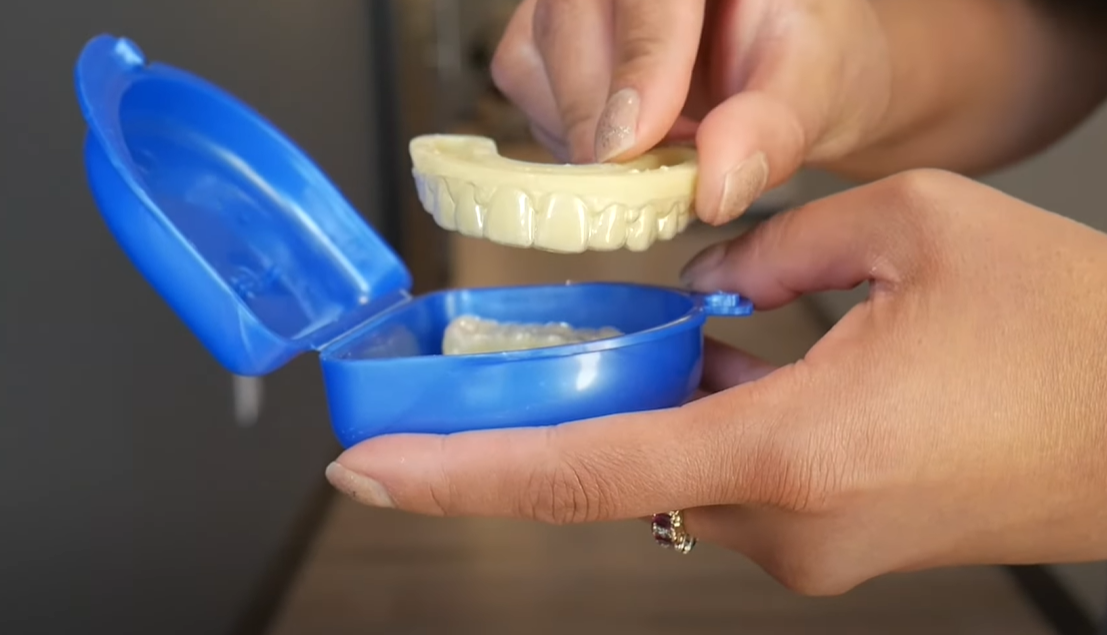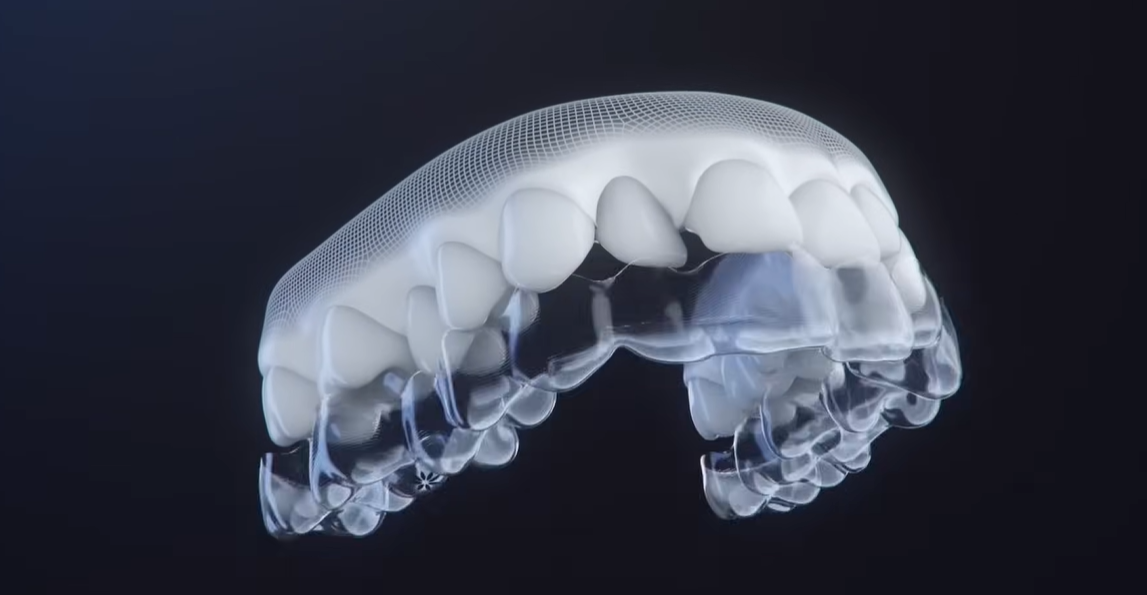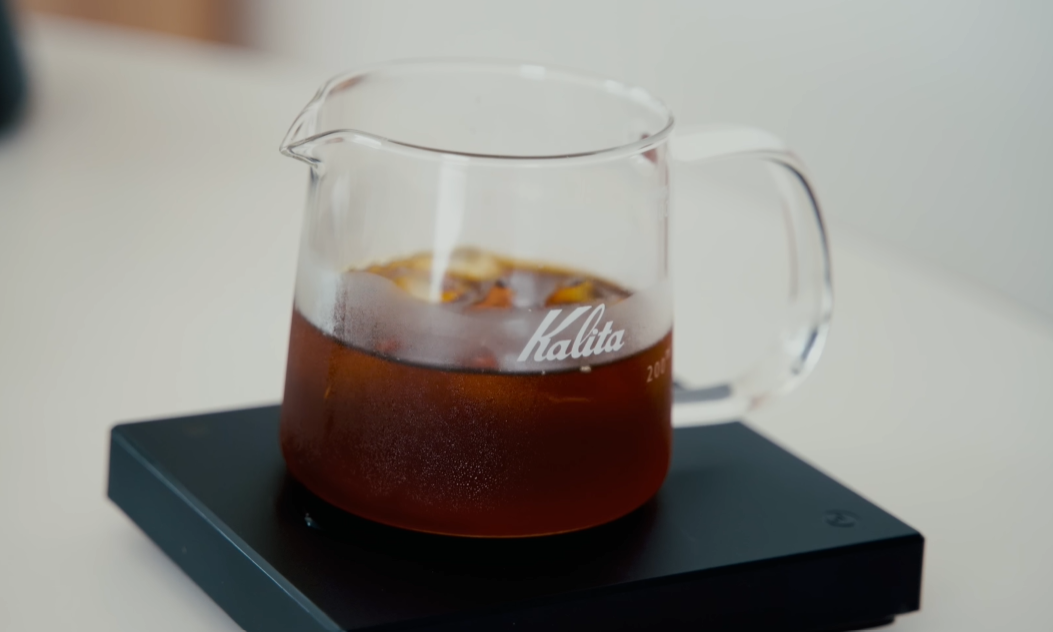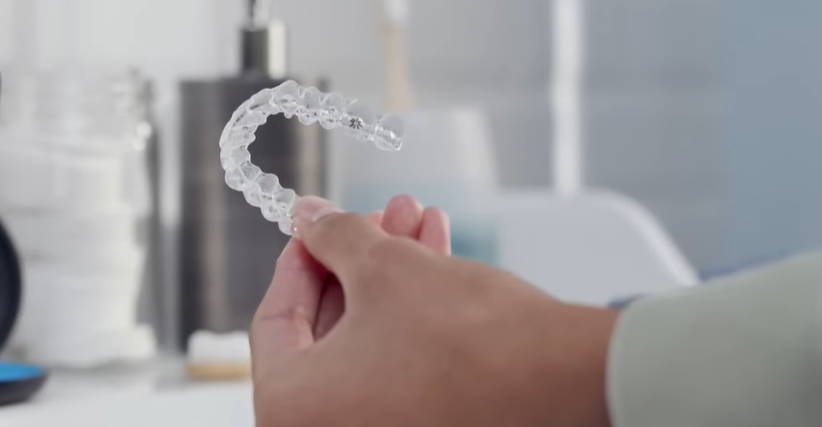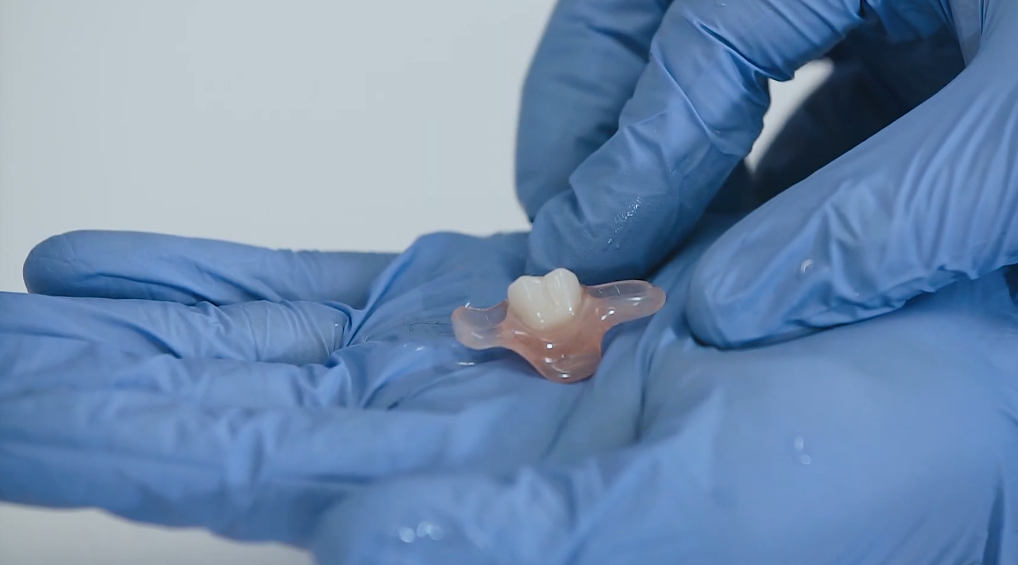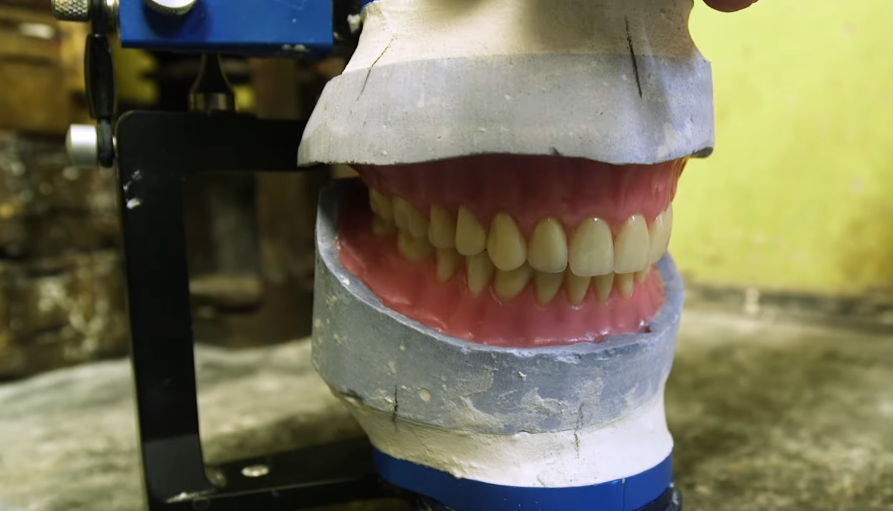If you buy through links on our site, we may earn a small affiliate commission to help support the blog - at no extra cost to you. It never influences our product selection process. Thank you!
Can you eat with pop on veneers? It’s a common question for anyone considering these temporary cosmetic dental answers. After all, what good is a beautiful smile if you can’t enjoy your favorite foods?
Pop-on veneers offer an affordable alternative to permanent dental work, giving you an instant smile makeover without drilling or anesthesia. But when mealtime comes around, you’ll want to know exactly what limitations these removable veneers might impose on your dining experience. Whether you’re considering brands like Snap-On Smile or other temporary veneer options, understanding their functionality during meals is essential for making an well-informed choice.
What Are Pop-On Veneers?
Pop-on veneers are removable dental appliances designed to cover your natural teeth and create the appearance of a perfect smile. These temporary cosmetic answers fit over your existing teeth like a shell, masking imperfections such as stains, gaps, chips, or misalignments.
How Pop-On Veneers Differ From Permanent Veneers
Pop-on veneers offer a non-invasive alternative to traditional porcelain veneers without requiring tooth reduction or permanent alteration. Traditional veneers involve removing a thin layer of enamel from your natural teeth before cementing custom-made porcelain shells to the front surface. Pop-on versions simply snap into place over your existing teeth and can be removed at any time.
Material composition sets these options apart significantly. Permanent veneers are crafted from high-grade dental porcelain or composite resin that mimics natural tooth enamel in both appearance and durability. Pop-on varieties typically use dental-grade resin or flexible polymer materials that provide aesthetic improvement but lack the same strength and longevity.
Cost differences make pop-on veneers particularly attractive for many patients. While permanent porcelain veneers range from $925-$2,500 per tooth, pop-on options generally cost $300-$1,000 for a full set.
“I had a patient who couldn’t afford traditional veneers but needed a confidence boost for her daughter’s wedding,” shares Dr. Todd B. Harris. “Pop-on veneers gave her that perfect smile for photos without breaking her budget, though I made sure she understood they weren’t designed for heavy-duty chewing during the reception dinner.”
Maintenance requirements vary dramatically between these options. Permanent veneers become part of your dental structure, requiring only normal brushing and flossing. Pop-on versions need removal for cleaning both the appliance and your natural teeth, plus overnight storage in appropriate answers to maintain their appearance and prevent bacterial growth.
Eating With Pop-On Veneers: The Basics

Pop-on veneers allow you to eat many foods while wearing them, but they do require exact care to maintain their appearance and durability. Following proper eating guidelines ensures your snap-on veneers stay in good condition and continue to enhance your smile throughout their lifespan.
Foods You Can Safely Eat
Soft foods are ideal companions for your pop-on veneers. Enjoy soft fruits like bananas, peaches, and berries without worry as they won’t strain your veneers. Cooked vegetables provide necessary nutrition while being gentle on your temporary dental appliances. Tender meats cut into small, manageable pieces work well, particularly chicken and other softer proteins that don’t require excessive chewing force.
Carbohydrates such as pasta, rice, and soft bread are excellent choices that won’t damage your veneers. Dairy products including yogurt, soft cheeses, and ice cream offer safe options that satisfy cravings without risking veneer integrity. Beverages like water, milk, herbal teas, and low-sugar juices complement meals without staining or damaging your pop-on veneers.
Dr. Todd B. Harris often mentions to patients, “One of my clients reported that switching to smoothies and shakes for breakfast actually improved her nutrition while protecting her new snap-on veneers—a win-win situation for both her smile and overall health.”
Foods To Avoid
Hard and crunchy foods pose important risks to your pop-on veneers. Nuts, hard candies, and raw vegetables might crack or dislodge your veneers, requiring replacement. Sticky foods such as caramel, taffy, and chewing gum can pull veneers out of position or cause damage to their structure.
Hot beverages and foods exceeding approximately 120°F may warp your veneers, affecting their fit and appearance. Dark-colored drinks including coffee, tea, red wine, and sodas contain staining agents that discolor your veneers over time. Acidic beverages like sports drinks, energy drinks, and alcoholic options can erode the material, shortening the lifespan of your pop-on veneers.
Eating with proper techniques helps preserve your veneers. Cut food into smaller pieces rather than biting directly with your front teeth. Chew slowly and gently, distributing food to your back teeth where possible. Rinse your veneers after meals to remove food particles that might cause staining or odors.
Tips For Eating With Pop-On Veneers

Wearing pop-on veneers doesn’t mean you can’t enjoy your meals, but it does require some adjustments to your eating habits. These practical tips will help you protect your investment while still enjoying a variety of foods.
Cut Food Into Smaller Pieces
Cutting your food into bite-sized pieces reduces stress on your pop-on veneers. Large bites require excessive force that can loosen or damage veneers over time. Take smaller bites and chew slowly with your back teeth rather than biting directly with your front veneers. Many patients find this simple adjustment makes a important difference in preserving their veneers’ appearance and fit.
Avoid Hard and Crunchy Foods
Hard and crunchy foods pose the greatest risk to your pop-on veneers. Items like nuts, hard candies, ice, and raw carrots can crack or chip the dental-grade resin material. Apples and other firm fruits should be cut into small pieces rather than bitten into directly. One patient reported how switching to softer food alternatives extended the life of her veneers by several months compared to her previous set.
Stay Away From Sticky and Chewy Items
Sticky foods like caramel, taffy, and chewy candy can pull on your veneers, potentially dislodging them or creating gaps where food particles can become trapped. Gummy candies and chewy protein bars also present similar risks. These items easily adhere to the veneer surface and can be difficult to clean off completely, leading to staining issues over time.
Be Cautious With Temperature
Temperature extremes can affect the fit and integrity of your pop-on veneers. Hot beverages or foods exceeding 120°F may warp the material, altering how they fit your teeth. Cold items aren’t typically problematic, but the transition between temperature extremes might cause subtle expansion and contraction of the material. Let hot foods and drinks cool slightly before consuming them while wearing your veneers.
Choose Veneer-Friendly Beverages
Water remains the safest beverage choice when wearing pop-on veneers. Coffee, tea, red wine, and dark sodas contain pigments that can stain your veneers over time. Acidic drinks like citrus juices, sports drinks, and carbonated beverages may gradually degrade the veneer material. If you do consume these drinks occasionally, using a straw helps minimize contact with your veneers.
Proper Cleaning After Meals
Immediate rinsing after eating prevents food particles from becoming trapped between your veneers and natural teeth. Remove any visible food debris by swishing water around your mouth thoroughly after each meal. Brush your veneers gently using a non-abrasive toothpaste and a soft-bristled toothbrush to preserve their polished surface. Taking a few minutes for proper cleaning extends the lifespan of your veneers considerably and maintains their bright appearance.
Common Challenges When Eating With Pop-On Veneers
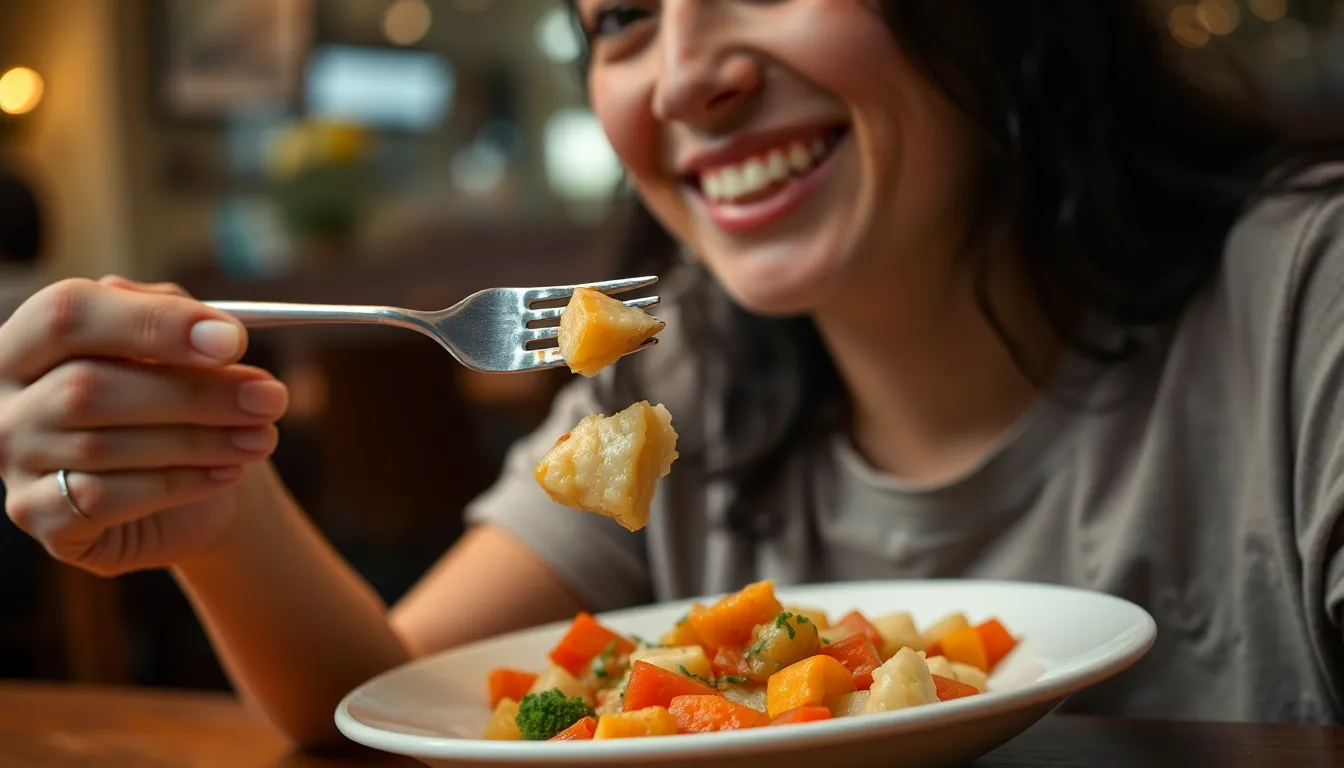
Eating with pop-on veneers presents several unique challenges that can affect your dining experience and the longevity of your dental appliance. Understanding these obstacles helps you navigate meals more confidently while protecting your investment.
Temperature Sensitivity
Pop-on veneers react poorly to extreme temperatures, making them vulnerable to warping when exposed to very hot foods or drinks. Many users experience discomfort when consuming items that are too hot or cold, as the veneer material can transmit these temperature changes directly to your teeth. Extremely hot beverages like freshly brewed coffee or tea can permanently alter the shape of your veneers, compromising their fit and appearance.
Hard, Crunchy, Sticky, and Chewy Foods
Biting directly into hard foods poses important risks to pop-on veneers. Foods like apples, carrots, nuts, and crusty bread create excessive pressure that can crack or dislodge your veneers. Sticky substances such as caramel, taffy, or chewing gum frequently adhere to the veneer surface, potentially pulling them away from your teeth. Chewy foods like steak or bagels require strong bite force that can stress the connection points of your veneers.
Staining Concerns
Pop-on veneers are susceptible to discoloration from pigmented foods and beverages. Coffee, tea, red wine, and dark sodas contain strong colorants that penetrate the veneer material over time. Certain foods like berries, tomato sauce, and curry can also leave behind stubborn stains. Unlike natural teeth, veneers can’t be whitened once stained, making prevention critical for maintaining their aesthetic appeal.
Fit and Comfort Issues
Ill-fitting veneers create friction points that become increasingly uncomfortable during meals. Pain or discomfort while eating indicates potential problems with your veneers that shouldn’t be ignored. Proper fit ensures that veneers stay securely in place throughout meals without shifting or causing irritation to your gums or tongue.
How To Prevent Damage While Eating
Selecting veneer-friendly foods significantly reduces risks to your pop-on veneers. Soft options like cooked vegetables, ripe fruits (bananas, peaches), pasta, yogurt, and tender meats cut into small pieces offer satisfying meals without endangering your veneers. Chewing slowly and deliberately helps minimize strain on your veneers during each bite. Cutting food into smaller, manageable portions before eating reduces the force needed to break down your food.
Temperature management plays a crucial role in veneer protection—allow hot items to cool slightly before consumption to prevent warping. Drinking water with meals not only promotes overall health but also helps rinse away potentially staining substances before they settle on your veneers. Rinsing your veneers promptly after eating removes food particles and reduces the chance of staining or bacterial buildup.
Long-Term Effects Of Eating With Pop-On Veneers

Consistent eating with pop-on veneers affects their durability and appearance over time. Improper food choices or eating habits can lead to premature wear, reduced functionality, and compromised aesthetics. Regular consumption of hard, crunchy, or sticky foods puts excessive stress on the veneer material, potentially causing cracks or chips that aren’t easily repaired.
Material Degradation
Pop-on veneers made from dental-grade resin or flexible polymers gradually deteriorate with regular food exposure. Chewing creates friction that wears down the veneer surface, making them appear dull or uneven after months of use. Hot foods exceeding 120°F might slightly warp the material, affecting the precise fit that made them comfortable initially. One of my patients, Sarah, noticed her veneers had developed small abrasions after just three months because she continued eating raw carrots and apples without cutting them into smaller pieces.
Staining And Discoloration
Frequent exposure to staining agents significantly impacts the appearance of your pop-on veneers. Coffee, tea, red wine, and colored sodas contain pigments that adhere to microscopic imperfections on the veneer surface. These stains accumulate gradually, becoming more noticeable over months of regular consumption. Acidic foods and beverages accelerate this process by creating tiny surface irregularities that trap colored particles more effectively. Daily cleaning helps minimize discoloration, but complete prevention remains challenging with regular exposure.
Structural Integrity Issues
Long-term consumption of hard or sticky foods compromises the structural integrity of pop-on veneers. Repeatedly biting into foods like nuts, hard candies, or crusty bread creates stress points that eventually lead to fractures. Chewy substances like caramel or taffy can dislodge veneers unexpectedly, potentially causing damage during removal. These structural failures typically occur along thin edges or in areas with previous micro-damage, making repairs difficult or impossible.
Bacterial Growth Concerns
Eating with pop-on veneers without proper cleaning afterward creates ideal conditions for bacterial proliferation. Food particles trapped between your natural teeth and the veneers form a breeding ground for bacteria, potentially leading to bad breath, gum irritation, and accelerated tooth decay underneath. Rinsing after meals removes some debris, but thorough cleaning requires veneer removal—something many users skip when eating multiple times daily. This bacterial accumulation becomes particularly problematic with extended wear periods.
Fit And Comfort Changes
The way your pop-on veneers fit changes subtly with extended use during meals. Continuous pressure from chewing gradually alters the shape of flexible veneer materials, resulting in looser or tighter areas that affect comfort. Temperature fluctuations from hot and cold foods further impact this process, as materials expand and contract slightly with each exposure. These accumulated changes make long-term users notice their veneers feeling less comfortable or secure during meals compared to when first purchased.
Conclusion
Pop-on veneers offer a non-invasive solution for a brighter smile without permanent dental alterations. While you can eat with them in place you’ll need to make thoughtful food choices and adopt exact eating techniques to protect your investment.
By avoiding hard sticky foods managing temperature extremes and maintaining proper cleaning habits you’ll extend the lifespan of your pop-on veneers. Remember that these temporary cosmetic appliances require different care than permanent veneers.
With the right approach you can enjoy meals while wearing your pop-on veneers and still maintain their appearance and functionality. Your beautiful smile doesn’t have to come at the expense of your dining pleasure if you follow these practical guidelines.
Frequently Asked Questions
What are pop-on veneers?
Pop-on veneers are removable dental appliances designed to cover natural teeth and mask imperfections like stains, gaps, chips, or misalignments. Unlike permanent veneers, they snap into place without requiring tooth reduction or permanent alteration, and can be removed at any time. Made from dental-grade resin or flexible polymer materials, they offer an affordable alternative to traditional porcelain veneers.
How much do pop-on veneers cost compared to permanent veneers?
Pop-on veneers typically cost between $300 and $1,000 for a full set, making them significantly more affordable than permanent veneers, which range from $925 to $2,500 per tooth. This price difference is one of the main reasons many people choose pop-on veneers as a cosmetic dental solution.
Can I eat normally with pop-on veneers?
No, you cannot eat completely normally with pop-on veneers. You should stick to softer foods like bananas, cooked vegetables, and tender meats. Avoid hard, crunchy, sticky, and chewy foods that can damage or dislodge the veneers. Cut food into smaller pieces, chew slowly, and be cautious with temperature extremes to maintain your veneers’ condition.
What foods should I avoid with pop-on veneers?
Avoid hard foods (nuts, hard candies, ice), crunchy items (chips, popcorn, raw carrots), sticky foods (caramel, taffy), and chewy foods (bagels, tough meats). Also limit consumption of hot foods exceeding 120°F and dark-colored or acidic beverages that can stain or erode the material. These restrictions help prevent damage and extend the lifespan of your veneers.
How do I maintain pop-on veneers?
Pop-on veneers require more maintenance than permanent ones. Remove them for cleaning after meals, brush them gently with a non-abrasive cleaner, and store them properly overnight. Rinse after eating to prevent staining and bacterial buildup. Avoid using toothpaste on the veneers as it can be too abrasive and damage the material.
Do pop-on veneers affect speech?
Initially, pop-on veneers may cause a slight lisp or speech adjustment period as your tongue adapts to the additional thickness in your mouth. Most users adjust within a few days to a week of consistent wear. Practice reading aloud to speed up adaptation. If speech problems persist beyond two weeks, consult your dental provider about possible adjustments.
How long do pop-on veneers last?
With proper care, pop-on veneers typically last between 1-3 years. Their lifespan depends on maintenance, eating habits, and how often they’re worn. Avoiding damaging foods, cleaning them properly, and removing them when not needed can extend their durability. Eventually, wear and staining will necessitate replacement.
Can I drink coffee or wine with pop-on veneers?
It’s best to avoid or limit coffee, wine, tea, and other dark-colored beverages while wearing pop-on veneers, as these can cause staining over time. If you do consume these drinks, use a straw to minimize contact with the veneers and rinse your mouth with water afterward. For special occasions, consider temporarily removing the veneers.
What are the signs that my pop-on veneers need replacement?
Look for visible cracks or chips, significant discoloration that doesn’t improve with cleaning, warping or changes in fit, rough edges that cause discomfort, or persistent bad odor despite proper cleaning. If your veneers no longer snap on securely or cause pain when wearing, it’s time for replacement. Most manufacturers recommend replacement every 1-3 years.
Are pop-on veneers a good alternative to permanent dental work?
Pop-on veneers serve as a temporary cosmetic solution, not a replacement for professional dental treatment. They’re ideal for special occasions or as an affordable option while saving for permanent procedures. They don’t correct underlying dental issues and may not be suitable for those with active decay, gum disease, or severely misaligned teeth. Consult your dentist before choosing this option.

